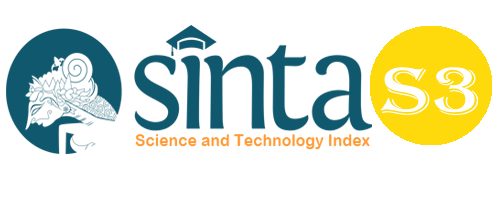Fraud Hexagon Elements as a Determination of Fraudulent Financial Reporting in Financial Sector Services
Abstract
The goal of this study is to examine the impact of all fraud factors. Hexagon Model in order to detect fraudulent financial reporting which will form a fraudulent financial reporting based on the fraud hexagon elements. The test for determining the elements of the fraud hexagon that affect fraudulent finan-cial reporting will use the Wald Test and G Test, the likelihood ratio test using the stepwise regression and forward regression methods. Furthermore, the fea-sibility test model will be carried out. If the model formed does not pass the series of tests, there will be some improvements to the model to test the regres-sion specification error test (RESET). This is the strength of this study if we compare to previous studies. This Study shows that The Opportunity is viewed from the ineffectiveness of the supervisor, and the change of the chairman of the internal auditor influences fraudulent financial reporting. Other causes include financial target pressure, external pressure, and personal financial demands; Opportunity in terms of external auditor quality; Rationalization based on external auditor change and audit opinion; Capability that is seen from a change of directors; The amount of images of CEOs and CEO politicians demonstrates arrogance; and collusion which is reviewed from the amount of audit fee has no effect on Fraudulent Financial Reporting.
Keywords
Full Text:
PDFReferences
Agusputri, H., & Sofie, S. (2019). Faktor - Faktor Yang Berpengaruh Terhadap Fraudulent Financial Reporting Dengan Menggunakan Analisis Fraud Pentagon. Jurnal Informasi, Perpajakan, Akuntansi, Dan Keuangan Publik, 14(2), 105. https://doi.org/10.25105/jipak.v14i2.5049
Albrecht, C., Holland, D., Malagueño, R., Dolan, S., & Tzafrir, S. (2014). The Role of Power in Financial Statement Fraud Schemes. Journal of Business Ethics 2014 131:4, 131(4), 803–813. https://doi.org/10.1007/S10551-013-2019-1
Altman, E. I. (2000). Predicting the Financial Distress of Companies: Revisiting the Z-score and ZETA Models.
Aprilia, A. (2017). Analisis Pengaruh Fraud Pentagon Terhadap Kecurangan Laporan Keuangan Menggunakan Beneish Model Pada Perusahaan Yang Menerapkan Asean Corporate Governance Scorecard. Jurnal ASET (Akuntansi Riset), 9(1), 101. https://doi.org/10.17509/jaset.v9i1.5259
Apriliana, S., & Agustina, L. (2017). The Analysis of Fraudulent Financial Reporting Determinant through Fraud Pentagon Approach. Jurnal Dinamika Akuntansi, 9(2), 154–165. https://doi.org/10.15294/jda.v7i1.4036
Arens, A. A. (2014). Auditing and assurance services : an integrated approach. Pearson. https://library.ui.ac.id/detail?id=20373522
Association of Certified Fraud Examiners (ACFE) Indonesia. (2018). Association of Certified Fraud Examiners (ACFE). Auditor Essentials, 7–10. https://doi.org/10.1201/9781315178141-3
Audrien, D. (n.d.). Sejak 2014, OJK Tindak Tegas 108 Kasus Kejahatan Perbankan. 2016. Retrieved October 25, 2021, from https://www.cnnindonesia.com/ekonomi/20161114120838-78-172491/sejak-2014-ojk-tindak-tegas-108-kasus-kejahatan-perbankan
Awang, Y., & Ismail, S. (2018). Determinants of financial reporting fraud intention among accounting practitioners in the banking sector: Malaysian evidence. International Journal of Ethics and Systems, 34(1), 32–54. https://doi.org/10.1108/IJOES-05-2017-0080
Bawekes, H. F., Aaron, S. M., & Daat, S. C. (2018). Pengujian Teori Fraud Pentagon terhadap Fraudulent Financial Reporting. Jurnal Akuntansi Dan Keuangan Daerah, 13(1). http://ejournal.akuntansiuncen.ac.id/index.php/JurnalAkuntansiUncen/article/view/39
Beneish, M. D. (1999). The Detection of Earnings Manipulation. Financial Analysis Journal, 55.
Brennan, N. M., & McGrath, M. (2007). Financial statement fraud: Some lessons from us and European case studies. Australian Accounting Review, 17(42), 49–61. https://doi.org/10.1111/J.1835-2561.2007.TB00443.X
Cressey, D. (1953). Other people’s money; a study of the social psychology of embezzlement. Free Press.
Crowe, J. (2012). Does Control Make a Difference? The Moral Foundations of Shareholder Liability for Corporate Wrongs. The Modern Law Review, 75(2), 159–179. https://doi.org/10.1111/J.1468-2230.2012.00895.X
Fathi, W. N. I. W. M., Ghani, E. K., Said, J., & Puspitasari, E. (2017). Potential Employee Fraud Scape in Islamic Banks: The Fraud Triangle Perspective. www.gjat.my
Hafizi. (2019). Vousinas’ Hexagon Fraud Determinan yang mempengaruhi fraudulent financial reporting (pp. 1–130).
Herdiana, R., & Sari, S. . (2018). Analisis Fraud Diamond dalam Mendeteksi Financial Statement Fraud: Studi Empiris pada Perusahaan Manufaktur yang Terdaftar di Bursa Efek Indonesia (BEI) Tahun 2013-2015. Prosiding Seminar Nasional Dan Call For Paper III, Universitas Muhammadiyah Ponorogo.
Ichsan, R. et al. (2021). Determinant of Sharia Bank's Financial Performance during the Covid-19 Pandemic. Budapest International Research and Critics Institute-Journal (BIRCI-Journal). P. 298-309.
Irianto, G., Novianti, N., Rosalina, K., & Firmanto, Y. (2012). Integrity, Unethical Behavior, and Tendency of Fraud. EKUITAS (Jurnal Ekonomi Dan Keuangan), 16(2), 144–163. https://doi.org/10.24034/J25485024.Y2012.V16.I2.213
Junardi. (2018). Analisis Pengaruh Fraud Pentagon terhadap Fraudulent Financial Reporting dengan Menggunakan Model Altman (Studi Empiris pada Perusahaan Sektor Keuangan dan Perbankan di Indonesia). http://download.garuda.ristekdikti.go.id/article.php?article=801177&val=11852&title=ANALISIS PENGARUH FRAUD PENTAGON TERHADAP FRAUDULENT FINANCIAL REPORTING DENGAN MENGGUNAKAN MODEL ALTMAN STUDI EMPIRIS PADA PERUSAHAAN SEKTOR KEUANGAN DAN PERBANKAN DI INDONESIA
Loebbecke, J., Dining. M., & Willingham, J. (1989). Auditor’s Experience with Material Irregularities: Frequency, Nature, and Detectability. Auditing: A. Journal of Practice & Theory, 9(1).
Lou, Y.-I., & Wang, M.-L. (2011). Fraud Risk Factor Of The Fraud Triangle Assessing The Likelihood Of Fraudulent Financial Reporting. Journal of Business & Economics Research (JBER), 7(2), 61–78. https://doi.org/10.19030/jber.v7i2.2262
Manurung, D. T. H., & Hardika, A. L. (2015). Analysis of factors that influence financial statement fraud in the perspective fraud diamond: Empirical study on banking companies listed on the Indonesia Stock Exchange year 2012 to 2014. International Conference on Accounting Studies (ICAS), August. www.icas.my
Nindito, M. (2018). Financial Statement Fraud: Perspective of the Pentagon Fraud Model in Indonesia. Academy of Accounting and Financial Studies Journal, 22(2), 1–9.
Oktafiana, N. F., Nisa, K., & Sari, S. P. (2019). Analisis Fraud Laporan Keuangan dengan Wolfe & Hermanson’s Fraud Diamond Model pada Perusahaan LQ45 di Bursa Efek Indonesia. The 5th Seminar Nasional Dan Call for Paper-2019 “Kebaruan Dan Kode Etik Penelitian “. http://jurnal.unmuhjember.ac.id/index.php/sncp/article/view/2022
Petriella, Y. (2015). Ini Faktor Pendorong Adanya Fraud dalam Bank - Finansial Bisnis.com. https://finansial.bisnis.com/read/20150311/90/410869/ini-faktor-pendorong-adanya-fraud-dalam-bank
Putriasih, K., Herawati, N. T., & Wahyuni, M. A. (2016). Analisis Fraud Diamond dalam Mendeteksi Financial Statement Fraud : Studi Empiris pada Perusahaan Manufaktur yang Terdaftar di Bursa Efek Indonesia (BEI) Tahun 2013-2015. JIMAT (Jurnal Ilmiah Mahasiswa Akuntansi) Undiksha, 6(3). https://doi.org/10.23887/JIMAT.V6I3.8808
Rachmawati dan Marsono. (2014). Perspektif Fraud Triangle terhadap Fraudulent Financial Reporting (Studi Kasus pada Perusahaan Berdasarkan Sanksi dari Bapepam Periode 2008-2012) | Rachmawati | Diponegoro Journal of Accounting. Pengaruh Faktor-Faktor Dalam Perspektif Fraud Triangle Terhadap Fraudulent Financial Reporting, 3, 1–14. https://ejournal3.undip.ac.id/index.php/accounting/article/view/6139
Ramdan. (2020). Asisten Manajer Oprasional BRI Bekasi Di Tuntut 11 Tahun Hukuman Penjara - Zona Bandung. https://www.zonabandung.com/hukrim/pr-120983575/asisten-manajer-oprasional-bri-bekasi-di-tuntut-11-tahun-hukuman-penjara
Ratnasari, E., & Solikhah, B. (2019). Analisis Kecurangan Laporan Keuangan: Pendekatan Fraud Pentagon Theory. Gorontalo Accounting Journal, 2(2), 98–112. https://doi.org/10.32662/GAJ.V2I2.621
Redaksi Indotimur. (2019). Tiga Pimpinan BNI 46 Maluku Ditetapkan Sebagai Tersangka Baru Kasus Dugaan Pembobolan Dana Nasabah - Indotimur. https://indotimur.com/hukrim/tiga-pimpinan-bni-46-maluku-ditetapkan-sebagai-tersangka-baru-kasus-dugaan-pembobolan-dana-nasabah
Repousis, S., Lois, P., & Veli, V. (2019). An investigation of the fraud risk and fraud scheme methods in Greek commercial banks. Journal of Money Laundering Control, 22(1), 53–61. https://doi.org/10.1108/JMLC-11-2017-0065
Saputra, M. A. R., & Kesumaningrum, N. D. (2017). Analisis Faktor –Faktor Yang Mempengaruhi Fraudulent Financial Reporting Dengan Perspektif Fraud Pentagon Pada Perusahaan Perbankan Yang Terdaftar Di Bursa Efek Indonesia Tahun 2011-2015. Undefined.
Sari, S. P., & Nugroho, N. K. (2020). Financial Statements Fraud dengan Pendekatan Vousinas Fraud Hexagon Model: Tinjauan pada Perusahaan Terbuka di Indonesia. IHTIFAZ: Islamic Economic, Finance and Banking(ACI-IJIEFB), 409–430. http://www.seminar.uad.ac.id/index.php/ihtifaz/article/view/3641
Septiadi, A., & Rafie, B. T. (2019). Begini kronologi hilangnya dana SAN Finance Rp 110 miliar di BTN. https://nasional.kontan.co.id/news/begini-kronologi-hilangnya-dana-san-finance-rp-110-miliar-di-btn
Sugianto, D. (2018). OJK Mulai Periksa Laporan Keuangan Bank Bukopin yang Dipermak. https://finance.detik.com/moneter/d-4002904/ojk-mulai-periksa-laporan-keuangan-bank-bukopin-yang-dipermak
Tessa, G. C., & Harto, P. (2016). Fraudulent Financial Reporting : Pengujian Teori Fraud Pentagon pada Sektor Keuangan dan Perbankan di Indonesia. Undergraduate Thesis, Fakultas Ekonomika Dan Bisnis. http://eprints.undip.ac.id/49099/
Ulfah, M., Nuraina, E., & Wijaya, A. L. (2017). Pengaruh Fraud Pentagon Dalam Mendeteksi Fraudulent Financial Reporting (Studi Empiris Pada Perbankan Di Indonesia Yang Terdaftar Di Bei. Forum Ilmiah Pendidikan Akuntansi, Vol 5 No.(1), 1–19.
Vousinas, G. L. (2019). Advancing theory of fraud: the S.C.O.R.E. model. Journal of Financial Crime, 26(1), 372–381. https://doi.org/10.1108/JFC-12-2017-0128
Widarti. (2015). Pengaruh Fraud Triangle terhadap Deteksi Kecurangan Laporan Keuangan pada Perusahaan Manufaktur yang Terdaftar Di Bursa Efeki Idonesia (BEI). Jurnal Manajemen & Bisnis Sriwijaya, 13(2), 229–244. https://doi.org/10.29259/JMBS.V13I2.3351
Wolfe, D. T., & Hermanson, D. R. (2004). The Fraud Diamond : Considering the Four Elements of Fraud: Certified Public Accountant. The CPA Journal, 74(12), 38–42.
Yusof, M. K., Khair, A., & Simon, J. (2015). The Macrotheme Review A multidisciplinary journal of global macro trends Fraudulent Financial Reporting: An Application of Fraud Models to Malaysian Public Listed Companies. The Macrotheme Review, 4(3).
DOI: https://doi.org/10.33258/birci.v5i1.4136
Article Metrics
Abstract view : 564 timesPDF - 296 times
Refbacks
- There are currently no refbacks.

This work is licensed under a Creative Commons Attribution-ShareAlike 4.0 International License.

This work is licensed under a Creative Commons Attribution-ShareAlike 4.0 International License.

_.gif)

















_.gif)



